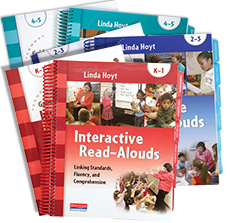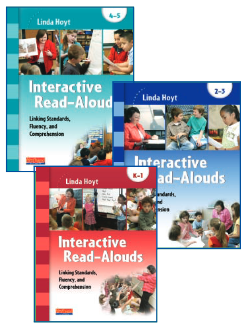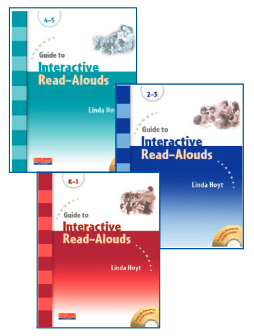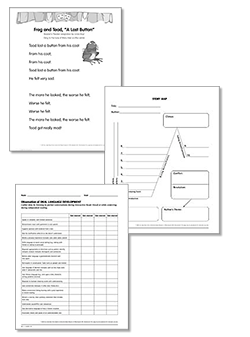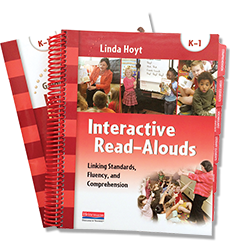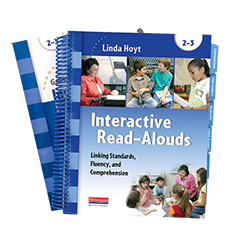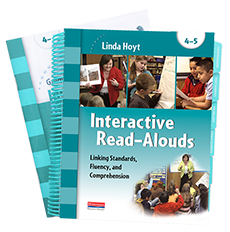Print out the samples below and try them out in your own classroom.
Planning Tools
Depending on your classroom need on any given day, you may choose to access an interactive read-aloud lesson in one of two primary ways: by standard or by title.
Lesson Matrix: When you have a particular standard that must be addressed for your curriculum or because children are developmentally ready for it, locate the standard on the following Lesson Matrix chart. Next to the standard you'll see the title of the mentor text that the lesson in this guide is based on as well as suggested Booklinks for extending learning with the same standard.
Title List: When you have a particular book that fits into your ongoing classroom activities, into your children's interests, or even into your mood on a given day, take a look at the Title List in the Teacher's Guide. Here, the mentor texts on which the interactive read-aloud lessons are based are listed alphabetically by title for ease of location. Find your book to see the standards and lessons it matches.
Lessons
A concise Lesson Plan models an interactive read aloud and then offers an end of story reflection and strategies for extending and assessing the learning.
Shared Reading Overhead Masters
The shared reading text in each lesson oftentimes introduces another genre (nonfiction, poetry) for strategy practice. It provides an opportunity for you and the children to read aloud together, building oral fluency while using strategies with a variety of texts. This full-size page may be made into an overhead transparency for group sharing and copied for children's literacy notebooks.
Reader's Theater Scripts
Each lesson includes a Readers Theater script that provides an opportunity to develop oral fluency. The script may recap or use the same language structure as the mentor test, introduce a new genre (e.g. nonfiction), or extend the story context. Readers Theater fluency practice focuses on reading expressively, matching the reading to the purpose and type of text, and should be joyous and engaging. Students should revel in the opportunity to show off their reading in a lively way.
The Interactive Read-Alouds lessons are grouped into six standards-based strands: comprehension, story elements, vocabulary/literary language, literary elements and devices, genre, and writing traits. Each of these strands was selected with great care after an extensive review of standards across the country to determine which standards show up as common threads across multiple states.
Comprehension. This strand—from utilizing prior knowledge and asking questions to summarizing and distinguishing real from make-believe—focuses on strategies that help learners negotiate the meaning of texts. Within this strand, you will find familiar terms such as main idea, cause and effect, analyze, and evaluate that commonly appear in lists of standards for comprehension.
Story Elements. The story elements strand includes identifying events in a plot sequence, discerning author's purpose, tracking character development, developing a statement of theme for a text, and so on. There is also support for examining structural elements such as climax, setting, problem/solution, and the role of the narrator.
Vocabulary/Literary Language. Standards in this strand encourage learners to observe the power of precise vocabulary; to identify and appreciate rhythm, rhyme, onomatopoeia, alliteration and literary language; and to discern the meanings of unfamiliar words through context clues. Transition words and words with multiple meanings are also highlighted in this strand.
Literary Elements and Devices. Literary elements and devices, such as point of view, foreshadowing, repetition, and exaggeration, get at the heart of the way an author structures a text to effectively tell a story. Standards in this strand involve readers in more complex story structures and more sophisticated language devices such as simile/ metaphor, and personification.
Genre. Genre categories—fiction, nonfiction, fairy tale, drama, and so on—each have a particular kind of content or structure. Exploring the standards in this strand, learners begin to understand the distinguishing features of various genres and learn what to expect from each.
Writing Traits. Engaging, well-written texts provide outstanding models for beginning writers. Standards in this strand explore ideas, organization, voice, conventions and so on, so learners can begin to emulate that writer's work and incorporate those traits into their own writing.
To review the Lesson Matrix that organizes the Mentor Texts and alternative Booklinks by strategy strand review the pdf files below:
(Excerpted from Interactive Read-Alouds Teacher's Guide)
The interactive read-aloud lessons in this collection bring together children and classic picture books to promote accelerated learning on multiple fronts. Several principles or beliefs about read-aloud practice guided their development.
Powerful Mentor Texts-Exemplary Children's Classics and Strong Nonfiction Texts-Are the Centerpiece of any Read-aloud.
Children deserve opportunities to interact with the richest language, most beautiful art and enticing storylines that we can offer. In selecting mentor texts, books that could serve as exemplary models for readers and writers, we turned to the gorgeous art and enticing storylines of Caldecott Medal winners as well as treasured favorites. These books offer characters and plots that enthrall our learners, texts that you want to revisit over and over again, and topics that will expand children's knowledge of the world.
Mentor Texts
The concept of a mentor text is important. A mentor is one who models, coaches, and lifts another to higher levels. With that in mind, a mentor text must be chosen carefully to ensure that it can establish a model of quality writing that is worthy of guiding our learners. With the help of a beautifully crafted mentor text, we can wonder together about the imagery, the possible themes, and the elements that have come together to create the literary magic that resides in these much-loved books. With a mentor text in hand, we can gently open children's eyes to the inner workings of the selection, savor its beauty, and create powerful links to the standards we want our children to understand.
The mentor texts profiled in these lessons were chosen for their ability to:
- boost language development
- promote active listening
- encourage deeper thinking
- provide outstanding models of fluency
- feature beautiful art
- support learning more about the world around us
- serve as models of great writing, and
- are time tested and easily available "classics"
Booklinks
The lessons in this book, all based on powerful mentor texts, are springboards to an in-depth look at a standard, a literary element, or a comprehension strategy in action. We know that true learning requires a sustained focus. We need to give children opportunities to apply new learning in many contexts over time if we want them to truly own the target understanding. Each of these lessons then is a beginning, a chance to open the window of possibility and help children begin a journey of deep learning.
After the initial lesson with the mentor text, turn to the Booklinks. You will notice that these additional Caldecott winners and familiar favorites exemplify the target standard, literary element, or comprehension strategy. They were chosen because they are particularly well matched to the target standard. The Lesson Matrix will guide you through the Booklinks as you continue to focus on the target learning begun in the mentor text.
What is vital is to extend the focus on a standard across many texts and multiple subject areas so the children can synthesize and apply their learning. Just because there is one mentor text doesn't mean you stop working on the standard or strategy. Booklinks are important extensions to long term understanding. Note that many of the Booklink titles appear as mentor texts for multiple standards. This is deliberate. Children need to understand the power of rereading with new purposes, to revisit with new eyes and discover the wealth of learning that resides in each of these wonderful books. Read it again and again and again!
Nonfiction
The lessons in Interactive Read-Alouds were built around mentor texts that are the easiest for you to find in schools, public libraries, and book stores. These books are time-tested favorites and award winners that are least likely to go out of print. There is, however, a sad feature to the convenience of selecting books that are readily available. Caldecott books and treasured favorites with easy availability are primarily fiction. While fiction is, of course, wonderful… it isn't enough. Our learners deserve to have the same in-depth experience and knowledge of nonfiction titles that they have with fiction. They deserve to have rich interactions with nonfiction read-alouds that not only capture kid-delightful, eye-popping information but also sing with exquisite language. They deserve to see that nonfiction texts can capture their interest, pique a sense of wonder, and bring the world alive with striking visuals and colorful language.
Because there is not an established body of familiar nonfiction books readily available in all libraries, broadening your children's experience with the target standards and comprehension strategies of these lessons will depend on you. I highly encourage you to go to your library and gather books by Seymour Simon, Gail Gibbons, Stephen Kramer, Michael Tunnell, and the many other amazing writers of nonfiction that are guaranteed to delight and intrigue your children. Then, using these books as additional Booklinks, model for your students how you can apply comprehension strategies and standards, such as main idea or word choice, as a reader of these delightful selections. This will help your students in a myriad of ways. They will be learning about the world. They will again realize that these standards and strategies will help them in any book they read. They will feel empowered because they will have meaning-seeking tools that they have practiced so well, they can apply them in all the texts they encounter.
I am an enthusiastic promoter of the power of nonfiction read-alouds and have developed several resources to that end, including Make It Real: Strategies for Success with Informational Texts (Heinemann, 2002); Exploring Informational Texts (Heinemann 2003); and Navigating Informational Texts video collection (Heinemann, 2004). I believe that learners of all ages need to understand the structure and features of informational text, learn the wonder and excitement of learning something fascinating about our world, and develop a sense of passion for nonfiction that will show in their eyes and voices when you bring out a new nonfiction book to share. I encourage and challenge you to gather wonderful magazines, books, and resources that allow you to extend your children's focus on a strategy into nonfiction. (See the Printable Resources CD-ROM for a lesson template to help you structure your own interactive read-aloud lesson using nonfiction selections.)
An Interactive Read-aloud with a Clear Instructional Focus Lifts Student Achievement.
Standards that are commonly held across many states are the driving force throughout these lessons. Each lesson, with its accompanying mentor text and Booklinks, is designed to help children see a standard in action within the supportive and safe context of a readaloud. Teacher think-aloud language and questions to stimulate quality partner conversations are all focused on the target standard so that children can listen to the teacher applying the standard, then share their thinking with a partner. This process is repeated with each mentor text as teacher modeling and guided practice are central support systems across the many books in which children apply the target standard.
You'll notice that in the lessons I use the language of the standards when talking to the children. I believe that all learners, from kindergarten on, can and should use the "real" language that describes our thinking about comprehension, literary elements and genre—point of view, characterization, alliteration, voice—call it like it is! Children then become comfortable using that language, as they converse with Thinking Partners. This explicit language enables children to label the cognitive processes they are using and to accurately categorize the story elements that build the rich infrastructure that holds a good story together.
Bull's-eye Concept
Each of the Interactive Read-Alouds lessons represents a Bull's-eye session and its extensions. During a Bull's-eye instructional session, I hone in on one particular strategy or idea in a piece of text. For this one lesson, instruction focuses on a single standard. This is not to say that this is the only direction a reading might take; a text might be the focal point for both point. of view and transition words, for example. Every book is rich with possibilities for instruction. The trick is to target one standard per lesson so it becomes transparent for the children.
To address additional standards, read the book again on another day and focus on a new teaching point. Children often make really charming comments and observations during a read-aloud—fine for a listen-for-pleasure experience—but the Think-Aloud and Turn & Talk for an interactive read-aloud lesson should be directed to one specific standard to help the learners keep track of the target learning.
Well-structured Interactive Read-aloud Lessons Create Environments in Which Children Are Strong Participants in their Own Learning.
Pearson and Gallagher (1983) coined the phrase "gradual release of responsibility" to describe the idea that instruction should begin with explicit modeling by the teacher followed with guided practice and then move on to activities that position students to become independent learners. The interactive read-aloud lessons you find here are built on just such a model. During "Interactive Read-Aloud," students see an expert at work.
The teacher models think-alouds to provide children with a window into a reading strategy and show how an accomplished thinker uses that strategy. Next, the teacher provides scaffolds for students as they stretch their new learning into another context. Carefully constructed learning activities in "Share the Reading" provide guided practice with the teacher actively supporting the learning. During the "Readers Theater" experience, children get further guided practice as they work with peers. Finally children attempt the strategy in an independent way, depending on themselves in "Extend the Learning."
Like the gradual release model that underpins Interactive Read-Alouds lesson design, the sample test items in each lesson's "Infusion of Formal Language" feature provide a gentle way to accustom children to the language of tests and, ultimately, to strengthen learners' responsibility for their own performance. The test questions that characterize standardized tests, end of unit tests, and so on are often written in a formal register that is very different from that of oral speech, and certainly different from most of the literature we read to our students (Hoyt, 2006). Embedding test-style language into your daily interactions with students and weaving this formal register into your conversations about books will help learners to become comfortable with these often unfamiliar structures. The "Infusion of Formal Language" section in each lesson will give you sample language to offer your students. The idea is to get them used to hearing these language structures, to think about what the question is really asking of them… and then to use these forms to wonder together about the mentor text. The objective isn't necessarily to answer the question correctly. It is to develop a sense of confidence with formal test style language and begin to think of it as "just another way we talk about our books."
The samples provided are springboards for you. You may want to post a list of common test-style stems and then deliberately use them as you talk with students about the books and stories you share.
Interactive Read-Alouds Open Up Opportunities to Develop Oral Language.
An analysis of traditional interactions between students and teachers reveals that teachers do the majority of the talking while children sit passively. Those students who do talk are often the predictable few who raise their hands quickly and love to be heard. Just as predictably, teachers know which students have learned to keep their hands down with their eyes averted in hopes that they will not be called upon. This interaction results in a very small number of learners who share their thoughts. Meanwhile, the struggling learners quickly figure out that if they are quiet long enough, a more verbal peer will speak and let them off the hook. Interactive read-aloud lessons recast this unproductive interaction and raise the level of responsibility for all learners.
- Turn & Talk (Float the learning on a sea of talk)
"Turn & Talk," an integral part of every Interactive Read-Alouds lesson, takes the traditional whole-class literacy experience and turns that experience into interactive thinking. Into every lesson I build regular, prompted turn-and-talk moments during which children and their Thinking Partners engage in sharing ideas about the text and the target standard. To set this up, I model my thinking, ask a question or prompt a discussion, and then direct students to talk to their Thinking Partners. Students are not allowed to raise their hands!
The expectation is for quality conversation on the topic in a short burst of 20-30 seconds so students stay focused and don't have enough time to stray off topic. (Jensen, 2000) Careful timing of Turn & Talk moments—approximately once in every five minutes of read-aloud time—ensures full engagement for all students, that the learning is full of meaningful talk, and that the students have immediate opportunities use the content vocabulary of the story.
- Thinking Partners
I am often asked about how Thinking Partners are chosen. I find that with some groups of learners I can ask them to find a Thinking Partner on their way to our story time area and it works beautifully. They sit with their partner and expect to have responsible conversations together. With some classes, I need to provide extra behavioral support by pre-selecting Thinking Partners for students. In this case, I would want to ensure that I do not match my highest and lowest achieving students as the higher achiever may have a tendency to take over and do all of the thinking. This is a good time to be sensitive to the needs of ELL learners who may need first language support and consider matching them with another child who speaks their native language.
In all cases, it is important to model Thinking Partner conversations. It is important that children understand that I place high value on quality talk and taking responsibility for thinking together. To help them understand, I often ask another teacher or a student in class to be my Thinking Partner. We sit facing each other while the students fishbowl around us to listen to our conversation and notice the way we look directly at our partners, practice active listening, and are careful to take turns talking. As they catch on, then
I bring two students to the center of the fishbowl to model quality Thinking Partner interactions. Once the Turn & Talk reflection is complete, you return to the read-aloud or—occasionally—celebrate children's thinking by asking partners to share their discoveries and wonderings out loud so others can hear the collaborative reflections.
- Share the Reading
One of the best ways to immerse children in rich language and extended learning is through shared reading. While shared reading was traditionally accomplished with big books, in these lessons overhead transparencies present text in a way that is highly visible to all. During "Share the Reading," a transparency is placed on the overhead using the master provided in the lesson. The teacher reads the selection aloud and invites children to again think together about the target standard. In this new context, the children will need to stretch their understanding of the standard to apply it in a different situation. This supports the transfer of the learning and increases the likelihood that students will take personal and independent control of the thinking that is targeted in the lesson.
Another added benefit is that we have now created a reading experience for the children. The shift from listening to the read-aloud to observing a text on the overhead increases time with text, provides additional exposure to print, and invites accelerated fluency development as the lesson encourages multiple readings of the selection for fluency and expression. You will find suggestions for modeling the reading, reading in unison, reading in teams that alternate lines of text and so on.
In some lessons, "Share the Reading" becomes an opportunity to model writing for the children. This is a wonderful chance for learners to see a proficient writer craft text while they watch the punctuation, spelling, grammar and word choice unfold on the overhead projector.
- Readers Theater
The Readers Theater scripts that are provided with each lesson bring an exciting element to the read-aloud—expressive oral reading and drama! The Readers Theater scripts are each based on a retelling of the read-aloud selection or designed to offer a related experience with a different genre or topic. They are designed to give children an authentic purpose for oral reading and are specifically crafted to support the target standard. Best of all, they are terrific vehicles for joyful, expressive oral reading that will build fluency in a way that makes it clear to children that fluency isn't just about FAST. It is about interpreting a selection and matching your rate, your intonation, and your phrasing to match the meaning and the kind of text you are sharing.
The scripts are flexible enough for emergent and developing readers but include concepts and ideas that are engaging for all readers. The scripts afford children opportunities to read different types of text (including nonfiction and poetry) and to become more fluent readers. Be sure to notice the Tips for Reader Theater in each lesson as you will find ideas for differentiating interactions with the scripts so they are fun for all learners.
Unlike a typical play, Readers Theater doesn't require props, staging, costumes, or even memorizing lines. The point of Readers Theater is to make readers the stars! As they take "center stage," children interact with the text in a deeper way. While Readers Theater gives students opportunities for increasing fluency and vocabulary, improving their comprehension, and communicating in a meaningful way, it's also a lot of fun! Teamwork is enhanced, too. Students of different abilities have the chance to read together and work together to transform written words into spoken ones—fluent and flowing language that excites students as they become more proficient readers.
